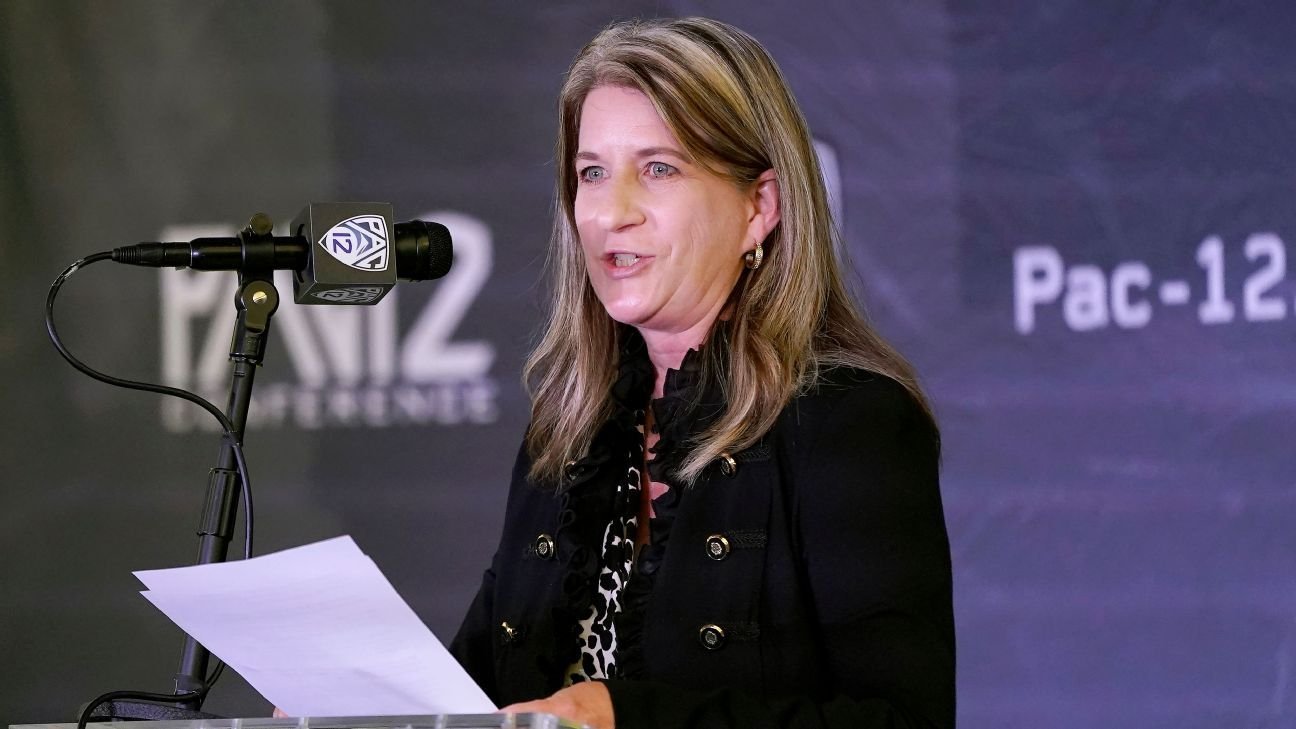In the cloak-and-dagger world of conference realignment, clues to potential moves can manifest themselves in strange places.
One emerged last week via a Twitter account with 313 followers promoting Texas State tailback Lincoln Pare for the Heisman Trophy.
The account included a picture — cribbed from the Instagram story of the Texas State president — of two beavers floating in the San Marcos River. And it noted the potential realignment ramifications — “Beavers in the San Marcos River” — by including a scratching chin emoji that hinted at the possibility of Texas State joining Oregon State in the Pac-12. (OSU’s nickname is, of course, the Beavers and the San Marcos River runs through the bustling town south of Austin where Texas State resides.)
This likely would have faded into the background of the Twitter-sphere if Texas State president Kelly Damphousse hadn’t retweeted it on June 10. That set off a spark in the wake of a regularly scheduled Pac-12 meeting earlier in the week when Texas State’s candidacy was a focus of discussion. (The Pac-12 declined comment for this story.)
So what’s next for the Pac-12? And what ripples could buzz through the kinetic realignment landscape? Here’s what could be coming in the next wave of realignment, which is expected to occur outside of the power conferences.
What’s next for the Pac-12?
Texas State is the heavy favorite, per ESPN sources, to be issued a formal Pac-12 invitation. The league is still engaged with other schools, per sources, but Texas State has clearly emerged at the forefront of that group.
On July 1, the buyout for Texas State to leave the Sun Belt for the 2026-27 season will rise from $5 million to $10 million. This is obviously a bigger motivator for Texas State than the Pac-12 but seemingly a significant enough deadline to trigger action.
For the Pac-12 to bring in a new partner in a time of financial uncertainty for the league, it would make sense to offer Texas State prior to July 1. After all, the Pac-12 needs an eighth football member for 2026, so they have their own deadline looming.
In realignment, of course, nothing is official until it’s signed. And nothing is formal until it’s completed. So with Texas State and the Pac-12, sources said the best way to explain the courtship is that the league is currently exploring making an offer in the upcoming weeks.
Texas State has loomed for months as the favorite to join the league and was prominently discussed in the Pac-12’s virtual meeting earlier this week. They have been the league’s top target for months and are expected to have voting support, as the league’s presidents are enamored with a foothold in the state and Damphousse’s leadership.
Texas State is booming as a university with an enrollment of more than 40,000, and it boasts a lot of tenets of football potential, with a rich local talent base and a rising young coach, G.J. Kinne, at the helm.
The league’s presidents won’t vote on Texas State until they are ready for the process to unfold in rapid-fire succession. That’s expected to come before July 1. Texas State turned down a verbal offer from the Mountain West last fall, which athletic director Don Coryell called “preliminary discussions with an interested conference.”
Texas State, if the Pac-12 process unfolds as expected, would be the league’s ninth member overall and eighth football member. Part of the feeling of inevitability of the invitation is tied to necessity. The league needs to grow to eight football members in order to qualify as an FBS conference. (Gonzaga is the non-football member.) Internally at the Pac-12, Texas State has long been viewed as the best readily available option for that eighth spot.
The exit fee looms as a significant motivator, as Texas State would join to start the 2026 season.
What would an offer look like? Well, Damphousse’s social media hinted at the expectations of that again. In April, he tweeted about his love of lobster bisque: “People sometimes think that I’d be happy with half a bowl of soup. After all, a cup of soup is better than no soup at all. But for me, it’s a full bowl or nothing.”
That line was in response to speculation that Texas State would go to the Pac-12 for part of a media share. It appears that Damphousse desires a full one.
It’s a reasonable expectation considering Gonzaga will be a full member of the conference in terms of media rights, despite not fielding a football team. However, Gonzaga won’t share fully in other football-related revenue.
Where does the Pac-12 go next?
The Pac-12 has flailed a bit since initially adding Fresno State, San Diego State, Boise State and Colorado State last year. It failed to add UNLV and Air Force, which stayed in the Mountain West for bigger slices of the pie, before adding Utah State.
The league’s goal was to add schools from the AAC, but Tulane had little interest and an initial courtship to add Memphis hit a hard stop because of finances. The exit fee to leave the AAC prior to the 27-month mark was estimated around $25 million. The Pac-12 only offered about $2.5 million to help with the buyout, which was rejected.
Where the Pac-12 goes beyond the eighth member is heavily tied to some clarity on the league’s financial future. The league’s television deal, with at least three partners, is expected to come together in the coming weeks. The timing of that deal, however, is not necessarily tied to the looming announcement of an eighth football-playing school.
In April, the Pac-12 agreed to a deal with the CW, ESPN and CBS to show the 13 home football games involving Oregon State and Washington State in 2025. Those partnerships are not binding into 2026, but Pac-12 commissioner Teresa Gould said previously the conference was looking for partners in 2025 that expressed interested in longer-term affiliations.
The finances from a new TV deal are expected to be below what the league’s consultants pitched schools initially. In the wake of the initial flurry of schools going to the league, ESPN reported schools were shown projected revenue from a TV deal north of $10 million per school, but conditions have changed.
That number projects under $10 million for the new deal starting in 2026 but is still expected to be more than those schools would have received had they remained in the Mountain West. The other financial variable is related to the buyouts for the five MW schools.
In September, the Pac-12 filed a lawsuit in federal court challenging the legality of a “poaching penalty” included in a football scheduling agreement it signed with the Mountain West in December 2023. It was a step the Pac-12 took to mitigate or avoid paying $55 million to the Mountain West, which the latter believes it is owed as result of its five schools leaving for the Pac-12. On top of that, there are individual buyouts those schools owe the Mountain West, which could collectively cost the schools more than $70 million.
Earlier this year, the Pac-12 — along with Boise State, Colorado State and Utah State — entered mediation with the Mountain West related to these fees, and it’s unclear how productive that process has been. Wherever things net out will likely factor into the conference’s next steps.
What’s next for Memphis?
In many ways, Memphis looms as the most interesting chess piece for future realignment outside of the power leagues. It has a strong basketball program, 11 consecutive years of bowl eligibility in football and significant outside financial support available.
There doesn’t appear to be much immediate interest in Memphis from the power leagues, per sources. And that remains Memphis’ ultimate goal, to get to the other side of the river.
If Memphis can’t figure out a way into a power league in the next few years – and there’s no imminent realignment moves expected at that level – there’s likely to be a further exploration of some type of split conference affiliation.
Pac-12 officials have discussed, per sources, Memphis coming on as a football-only member. This idea was made public in reports in the fall by USA Today. The rest of that athletic department’s sports would go to the Big East. This would allow Memphis to maximize basketball revenue against strong competition and save the travel of non-revenue sports going out West.
The calculus in Memphis’ decision making will depend on myriad factors. That includes the amount of the media deals in the Pac-12 and what happens with that league’s mediation with the Mountain West.
Memphis made $11 million all-in in the AAC last year. That’s a number expected to be ahead of what the Pac-12 will pay its full members.
What would a combination look like? (The new Big East deal is expected to dole out nearly $7 million per school annually, so the Memphis question would be whether its added inventory could grow the pie to keep that number whole.)
Memphis is such a crucial piece to the cluster of leagues outside the power conferences, as it’s one of the AAC’s bell cows. And a Memphis departure could create potential ripples, which is why their upcoming moves are the linchpin of any significant upcoming movement.
The expectation in the Pac-12 is that no movement for Memphis to the Pac-12/Big East would be expected to be seriously discussed until at least a 2027-28 start date.
What would be the dominoes of the Pac-12 adding Texas State?
While sources stress there’s been no formal invitation yet for Texas State, the move has reached the point where the Sun Belt is preparing for a departure.
In the fall, when Texas State was flirting with other leagues, the Sun Belt had started to put together contingency plans. That included conversations, per sources, that established Louisiana Tech as the favorite over several other targets, including Western Kentucky, if Texas State were to leave. There would still need to be more discussion and presidential action before any addition.
Louisiana Tech’s location aids them here, as the Sun Belt plays in divisions in football and a Texas State departure would mean a vacancy in the West.
The early appeal of Louisiana Tech that’s been talked about, per sources, is that it has the geographic location to create natural rivalries and easy travel with ULM, Louisiana and Southern Miss. All are in the same geographic footprint, and Louisiana Tech brings a strong tradition in baseball and softball, which are valued by the Sun Belt.
The Sun Belt’s realignment strategy for years has been to double-down on regional rivalries, and Louisiana Tech would fall into that category.
Western Kentucky would be attractive because of the program’s strong history in football and long-standing success in men’s basketball. They’d have some support from schools in the East, but the early read is that Louisiana Tech is ahead.
Per the Conference USA bylaws, a departing school would owe two years of revenue distribution and need to buy back the grant of rights. For a school to leave for 2026, the cost projects to be more than $5 million.
Conference USA officials are concerned enough about the potential ripple to their level that they’ve begun strategizing behind the scenes to replace a member school being poached.
If Louisiana Tech or another school departed Conference USA and the league was to expand up from 10 members, the favorite for the spot in Conference USA is Tarleton State University. That school has shown a significant financial commitment to athletics.
#College #realignment #intel #Texas #State #cryptic #posts #Pac12s #move



